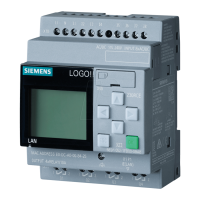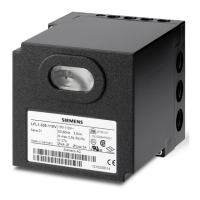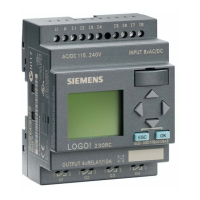
Do you have a question about the Siemens LGA41.153A27 and is the answer not in the manual?
| Safety Time TS after flame failure | 3 s |
|---|---|
| Safety Time TSA during start-up | 3 s |
| Manufacturer | Siemens |
| Category | Controller |
| Model | LGA41.153A27 |
| Mains Voltage | 230V AC |
| Mains Frequency | 50 Hz |
| Flame Detector | QRA... |
Supervision, startup, and control of atmospheric gas burners without a fan.
Controls for gas burners/units with or without fan, compliant with EN 298.
LGA41.173A27 and LGA52.171B27 suitability for air heaters.
Essential notes to prevent injury, damage, and environmental hazards.
Adherence to national safety regulations during mounting.
Correct placement of ionization probe and ignition electrode to prevent arc over.
Guidelines for high-voltage cable routing and terminal connections.
Ensuring disturbance-free signal transmission for the ionization probe.
Mandatory safety checks during commissioning and maintenance.
Details on applied directives, standards, and conformity marks.
Designed lifetime, usage, and proper disposal of electronic components.
Plug-in design, impact-proof housing, thermal sequencing, flame amplifier.
Prevents startup or triggers lockout if mains voltage drops below AC 165 V.
Overview of burner control types and their features.
Plug-in bases and cable holders for small burner controls.
Ionization probes and actuators like SQN3, SQN7, SQN9.
RC unit for ionization current supervision in specific networks.
Mains voltage, frequency, power consumption, protection, safety class, input current.
Storage, transport, and operation conditions for climatic and mechanical factors.
Detector voltage, current, and cable length for reliable flame supervision.
Using a transformer to boost detector voltage for AC 110V controls.
Diagram for connecting a transformer for AC 110V burner controls.
Essential input signals and safety conditions for burner startup.
Safeguards against undervoltage and reversed polarity connections.
Timing for prepurge, preignition, ignition safety, and postignition phases.
Immediate deactivation and lockout indication upon fault detection.
Mapping of fault causes to specific responses for LGA41 and LGA52/63 models.
Schematic of internal workings and sequence for LGA41 burner controls.
Schematic of internal workings and sequence for LGA52/LGA63 burner controls.
Wiring diagrams for LGA41 and LGA52/LGA63 burner controls.
Timing diagrams for the burner control sequences of LGA41 and LGA52/LGA63.
Physical dimensions of the LGA burner controls and plug-in base.












